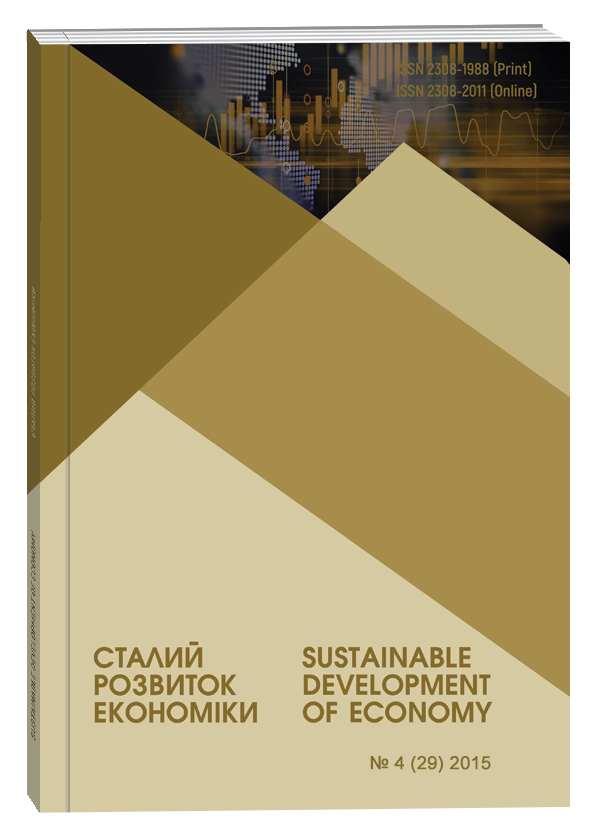FEATURES PLANNING AND ALLOCATION OF INDIRECT COSTS IN THE CONTEXT OPTIMIZATION OF FINANCIAL RESULTS OF INDUSTRIAL ENTERPRISES
Abstract
Purpose – to develop approaches to planning and allocation of indirect costs in view of optimizing financial results of enterprises. Methodology of research. When writing an article following methods were used: structural and logical analysis – in the construction of the logic and structure of the work; detail and method of synthesis for the study of the subject and interrelationships of its component parts. In addition, the general scientific methods of analysis used and the specific methods of economic research: observation and comparative analysis, synthesis and group data, historical and logical approach, and the like. Finding. Some problems revealed in decision-making during the formation of the production program of the company. Established that allocation of indirect costs in proportion to direct payroll or the total amount of direct costs of the enterprise leads to distortion of information used in the optimization of assortment of industrial enterprises. The new flexible planning tools for industrial companies using break-even factor in the allocation of indirect costs in proportion to the profit margin that economists provide more accurate information on such factors as the cost of products, price and profit. Originality. The methodical approach of allocation of indirect costs and the formation of the production program in the context of optimizing the financial results of industrial enterprises. Practical value. Ways of improving the system of planning at industrial enterprises through the introduction of flexible planning, using appropriate tools that will optimize the financial results of industrial enterprises.
References
Іванова В.В. Планування діяльності підприємства : [навч. посібник] / В.В. Іванова. – К. : Центр навчальної літератури, 2006. – 472 с.
Хан Д. Планирование и контроль: концепция контролинга / [Перевод с нем. ; под ред. А.А. Турчака, Л.Г. Головача, М.Л. Лукашевича]. – М. : Финансы и статистика, 1997. – 800 с.
Хойер В. Как делать бизнес в Европе / В. Хойер ; вступит. слово Ю.В. Пискулова. – М. : Прогресс, 1992. – 253 с.
Савчук В.П. Финансовый менеджмент предприятий: прикладные вопросы с анализом деловых ситуаций / В.П. Савчук. – M. : Издательский дом «Максимум», 2001. – 268 с.
Лівошко Т.В. Аналіз методів планування прибутку на промислових підприємствах /
Т.В. Лівошко, А.О. Книрик // Економічний вісник Запорізької державної інженерної академії. – 2014. – № 6. – С. 159-163.
Витрати : Положення (стандарт) бухгалтерського обліку 16. – К. : Компас, 2004. – С. 148-160. 7.Орлов О.О. Маржинальная прибыль в экономических расчетах на промышленных предприятиях / О.О. Орлов, Е.Г. Рясных. – К. : Издательский дом «Скарбы», 2003. – 132 с.
Орлов О.О. Застосування маржинального аналізу та аналізу чутливості під час формування виробничої програми машинобудівного підприємства / О.О. Орлов, Є.Г. Рясних, Т.А. Гордєєва // Економіка промисловості. – 2012. – № 1. – С. 252-258.
Ivanova, V.V. (2006), Planuvannia diialnosti pidpryiemstva Planning of the company, tutorial, Tsentr navchalnoi literatury, Kyiv, Ukraine, 472 p.
Khan, D. (1997), Planirovanie i kontrol: kontseptsiia kontrolinga Planning and control: controlling concept, Translated by A.A. Turchak, L.G. Golovach and M.L. Lukashevich, Finansy i statistika, Moscow, Russia, 800 p.
Khoyer, V. (1992), Kak delat biznes v Evrope How to do business in Europe, Progress, Moscow, Russia, 253 p.
Savchuk, V.P. (2001), Finansovyy menedzhment predpriiatiy: prikladnye voprosy s analizom delovykh situatsiy Financial management of the enterprises: applied questions with the analysis of business situations, Izdatelskiy dom «Maksimum», Moscow, Russia, 268 p.
Livoshko, T.V. and Knyrnyk, A.O. (2014), “Analysis planning methods in industrial profits”,
Ekonomichnyi visnyk Zaporizkoi derzhavnoi inzhenernoi akademii, no. 6, pp. 159-163.
Vytraty [Costs] (2004), Polozhennia (standart) bukhhalterskoho obliku 16 [Position (Standard) 16], Kompas, Kyiv, Ukraine, pp. 148-160.
Orlov, O.O. and Riasnykh, Ye.G. (2003), Marzhinalnaia pribyl v еkonomicheskikh raschetakh na promyshlennykh predpriiatiiakh Marginal profit in economic calculations in industrial plants, Izdatelskiy dom «Skarby», Kiev, Ukraine, 132 р.
Orlov, O.O., Riasnykh, Ye.H. and Hordieieva, T.A. (2012), “The use of marginal analysis and sensitivity analysis in the formation of the production program of machine-building enterprise”, Ekonomika promyslovosti, no. 1, pp. 252-258.


